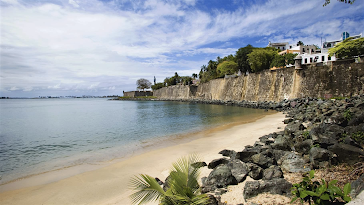Hurricanes, tsunamis, floods, and storm surges are just a few of the natural coastal hazards that Puerto Rico suffers as part of the Caribbean island. Communities in Puerto Rico are highly to very sensitive to coastal hazards due to the island's high population density (430/km2) and concentrated development in the coastal zone. 60% of the beaches are eroding on the island, making the island more susceptible to coastal hazards like the impacts of Hurricane Maria in 2017 that hit the island.
The USGS currently has a total water level forecast on sandy beaches that serve the eastern coast of the United States and the Gulf of Mexico. In order to accomplish this effort, they are working on cameras that will take pictures of the beach that can be accessed in real-time remotely from their office in St. Petersburg. In addition, they need instruments in the water, so they deploy oceanographic instruments to better understand how waves move across coral reefs into the shorelines. With this information, they can measure waves before they reach the reef to study how the reef helps dissipate wave energy and to develop the water level forecast for the island.
This susceptibility of being affected by coastal hazards is frequently made worse by careless coastal construction methods, the devastation of mangroves and other coastal habitats, and inadequate enforcement of environmental regulations. Reducing risk and loss of life and property through technology and information provided by Sea Grant researchers and marine advisers active in risk management and mitigation remains the major challenge. Through funding research initiatives that have resulted in flood models and maps, tsunami simulation tools, and public perceptions of risk, Sea Grant researchers encourage socioeconomic assessments that provide insight into the effects of coastal disasters on the economy and the efficacy of mitigation measures. Mitigation must come through prohibiting construction in high-risk zones, encouraging wider adoption of setback principles (e.g., Villa Palmira), relocating after storms, enforcing anti–sand-mining regulations, and better public education.
Sources:
https://www.usgs.gov/media/videos/puerto-rico-coastal-hazards
https://seagrantpr.org/outreach-program/coastal-hazards/
https://pubs.geoscienceworld.org/gsa/books/book/615/chapter-abstract/3805192/Summary-of-Puerto-Rico-s-vulnerability-to-coastal?redirectedFrom=fulltext


